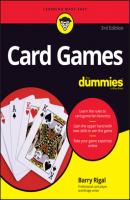Card Games For Dummies. Barry Rigal
Чтение книги онлайн.

Читать онлайн книгу Card Games For Dummies - Barry Rigal страница 16
Название: Card Games For Dummies
Автор: Barry Rigal
Издательство: John Wiley & Sons Limited
Жанр: Сделай Сам
isbn: 9781119880448
isbn:
After you work your way through the stock, pick it up and start again; continue until you either finish the game or get stuck and can’t move any further.
As soon as a card equivalent in rank to the foundation base card emerges from either the reserve pile or the stock, pick the card up and put it in a separate pile in the foundation, above the tableau. You can build only the next higher card of the matching suit, and no other card, onto the foundation.
Take a look at an example layout of the start of a game in Figure 2-6.
FIGURE 2-6: Starting a game of Canfield.
You’re in luck! This layout is a very promising start. The ♣Q joins the ♦Q at the top of the foundation, in a separate pile. This move creates a gap in the tableau where you can place a card from the reserve pile.
CARE TO TAKE MR. CANFIELD’S BET?
The story of where the Solitaire game Canfield got its name is a good one. At the turn of the century, Mr. Canfield ran a gambling salon where he made a bet with his customers. By paying $50, the customer received a well-shuffled deck of cards to play an abbreviated form of the game that now bears Mr. Canfield’s name. For every card in the foundation piles at the moment when “time” was called (after three turns through the stock), the customer received a return of $5. The odds of winning the bet were heavily weighted in favor of the proprietor, but customers still flocked to take him up on the bet. The problem from the casino owner’s perspective was that the game required a casino employee to watch over every gambler who took up the bet, thereby reducing the profitability of the game.
The red 3 goes on the black 4, and the black 2 goes on the red 3. Another card from the reserve pile fills the gap in the tableau left by the black 2.
Striking Gold with Klondike
Klondike, frequently misnamed Canfield (see the previous section), is by far the most frequently played Solitaire that I know. You need only a little time and a little space. In addition, you have a good chance of winning at Klondike — you may find yourself winning half the games you play.
Klondike requires little tactics or strategy. It’s an ideal game for children, perhaps for that very reason, and I think that Klondike was the first Solitaire that I ever played. Klondike is also an ideal Solitaire for a spectator, who can lean over the player’s shoulder and say things like “Put the red 7 on the black 8” until the player loses patience and punches the spectator in the shoulder.
The object of Klondike is to build up piles of the four suits from the ace (the lowest card) to the king on the foundation. You don’t start with any cards in the foundation; you collect cards for it during the course of play.
To build the initial layout, or tableau, you deal seven piles, with one card in the first pile, two in the second pile, three in the third, and so on. Turn over the top card of each pile as you deal out the cards.
You build on the top cards of each pile by putting the next-lower numbered cards of the opposite color on the top cards. Your building cards come from the stock.
To start the game, you play the cards in the stock, which should consist of 24 cards. Go through the stock three cards at a time, putting the cards into a waste pile, while preserving the order of the cards in that pile. You have access to only the top card of each set of three. If you use that top card, you gain access to the card below it, and so on. When you finish going through the stock, gather it up and go through it again.
You may go through the stock only three times. If you can’t persuade the Solitaire to work out after the three turns, you lose the game. However, most people that I know ignore the three-times rule and continue with the Solitaire until it works out, which it does a fair percentage of the time.
You can move the turned-up cards around (leaving the face-down cards in place), and whenever you move all the face-up cards from one pile of the tableau, you turn over the new top card.
When you use all the cards in a pile, you create a space. You can move any king, or pile headed by a king — but only one headed by a king — into the space, and then you turn another face-down card over on the pile from which you moved the king pile.
Whenever you turn up an ace in the tableau (or in the stock), move that card to the foundation and start a new foundation pile. You may then take any top card from the tableau and move it onto the foundation, where appropriate. For example, after you put the ♦A in the foundation, you can take the ♦2 when it becomes available to start building up the diamonds.
Living La Belle Lucie
As far as I’m concerned, La Belle Lucie (which is also known as Midnight Oil, Clover Leaf, the Fan, or Alexander the Great) is the best Solitaire that I’ve played. Every move is critical. The game requires great planning and forethought and rewards the player with a healthy chance of success.
I’ve been known to take more than 10 minutes to make a move while I plan the intricacies of competing strategies. It’s certainly not СКАЧАТЬ